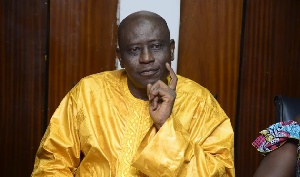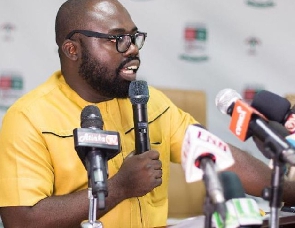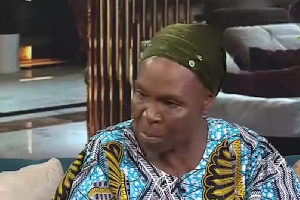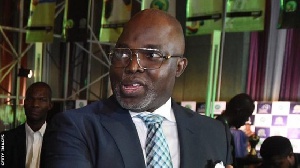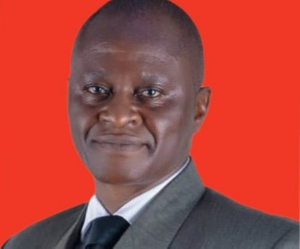By Richard Avornyotse, GNA Sports Desk
Accra, July 13, GNA - Born in Accra to the late Nana Kumi Bredo I, chief of Okorasi in the Akwapim Traditional Area and the late Diana Dodoowa Dodoo of Accra in 1929, Charles Kumi Gyamfi began playing football when he enrolled at the Junior School at Okorasi in 1936. Though he was only seven, his special talent at the round leather game soon became noticeable and he became an integral part of the School XI and played regularly among boys who were much bigger and taller than him.
In 1944, young Gyamfi moved to Accra and due to his prowess at football, he was admitted to Accra Royal School at the time when admission had closed and there was indeed no vacancy. "I told coach Ataa Nii Katoe that I could play better than most of his players and when he gave me the opportunity I played very well and he took me to the Headmaster for admission," Nana recalled with nostalgia.
After playing for the junior team, C K Gyamfi was asked to skip the intermediate team and join the senior team because his skills and general performance were considered to be above the middle level. It was at that time that he became very enthusiastic about football because he was privileged to play for Accra Royal against other schools in very competitive matches.
In one of such matches, C K, as he was popularly referred to in football circles, was spotted by officials of Noble Arrics, the junior team Great Argonauts and was coaxed to play his first club football for the Accra team.
When he completed school in 1947, C K moved to Koforidua in the Eastern Region and took up a job with A G Leventis. Anxious to continue playing football, he joined the local Sailors Football Club in 1948 and after excelling in a match against Cape Coast Mysterious Dwarfs, at Koforidua, he was persuaded to join Dwarfs which was a much bigger club than Sailors.
Early in 1949, C K played for Dwarfs against Kumasi Asante Kotoko at the Old Fadama Park in Accra and his exploits compelled Kotoko officials to seek his services. Thus, he moved to Kumasi in1949 and worked for CFAO, while playing for Kotoko.
He recalled that it was at Kotoko that he played alongside national team players and actually earned his first cap in 1950. In 1951, CK travelled with the Gold Coast XI team that toured England and Ireland. On the tour, the barefooted Gold Coast team scored a total of 25 goals and C K accounted for 11 of them.
When the team returned to Ghana, C K and E C Bryant decided to play in football boots and they introduced the boots in Ashanti and the Southern Gold Coast respectively, thus copying the players of Excelsior, the all-European team that was based at Cape Coast.
Through the instrumentality of C K, Mr. De Graft Dickson who was then the chairman of Kotoko bought boots for the entire Kotoko team but most of the players refused to use them and when they finally did, they played so badly that Kotoko lost the match.
On his most memorable match C K recalled a 1953 encounter between the Gold Coast XI and Nigeria in Accra.
"The Jalco Cup was at stake and the match was heading for a draw and that would have given Nigeria the cup. Suddenly a cross came to me and I controlled the ball and dribbled a defender before shooting with my unfamiliar left foot and the ball was in the net," he recalled with absolute glee.
After captaining Kotoko for some time, C K resigned and founded Kumasi Great Ashantis in 1954, but two years later, he returned to Accra and played for Accra Hearts of Oak where he chalked many successes with the club, including winning the Tate and Lyle and the League Cups in 1958.
When he played for the national team against the visiting Fortuna Dusseldorf team from Germany, the German team offered C K the opportunity to play professional football in Germany. In his debut, he scored a goal for the German team and the fans soon nicknamed him "Tunda Vita" which means Thunder Weather due to his shooting power.
His professional career was short lived as he was called back home in 1961 to help in shaping the Black Stars. C K became the assistant national coach, helping Hungarian Joseph Ember. In 1962 Ember left and the mantle fell on C K to prepare the Black Stars for the African Cup of Nations, which the country was to host the following year.
His first major assignment was the Uhuru Cup in Kampala to usher in Uganda's independence and the competition featured Kenya, a team from England and the host nation Uganda.
The Black Stars won the trophy and followed it up with the West African Gold Cup in the same year.
Though Ghana won the Nations Cup in 1963, pundits believed C K won with the team that had been prepared by Ember and some people actually called for his removal as national coach.
He however had the support of the late Mr Ohene Djan who was the Director of Sports and had overall responsibility for hiring and firing coaches.
As the African championship team was aging, C K had to replenish the squad and he got on board a new breed, which included Osei Kofi, Frank Odoi and Willie Evans and worked hard on the new team in readiness for the defence of the African title in Tunisia in 1965.
CK's Black Stars successfully defended the title as they defeated their Tunisian hosts in the finals by three goals to two.
He remained in oblivion after the military take over of government in 1966 and surfaced only in 1972 when he was appointed by CAF to manage the African XI in a tournament in Brazil which involved Japan, Argentina, France and Italy.
At the end of the tournament, he joined GIHOC and developed a soccer team, which became a fearful side in the country.
In 1981, he went to Brazil for a refresher course and returned to take the Black Star to the Cup of African Nations (CAN) in Libya in 1982. He won his hat trick of African titles at this tournament and remains to date, the only coach to have won the title three times.
After his triumph in Libya, C K sojourned to Somalia to take up appointment with the Municipal Club and guided them to their first league title in 1983 and repeated the dose the following year. Impressed by his performance, the Somali Federation put him in charge of their Youth Team for the African Under 21 competition. Though the team lost narrowly, 0-1 to Nigeria in Lagos after eliminating Kenya, C K was commended for developing the team.
Love of adventure and challenges took him to Kenya from Somalia and he soon announced his arrival by steering the Leopards to win the league title. Despite his success in Kenya, patriotism compelled C K to return to Ghana in 1991 with the intention of coaching the Black Stars for Senegal 1992.
Unfortunately, those who were in charge of appointing the national coach preferred Burkhard Ziesse to the treble African champion who was resigned to paper work in the office, as Technical Director without any powers to influence how the team was being selected or groomed. CK then pitched tent with Obuasi Goldfields and helped in the establishment of their academy, as well as supervising the team to win the first professional league in Ghana in 1993. He retired from active coaching after the league triumph and was appointed a CAF Technical Instructor in 1994. He also served on the FIFA Technical Committee from 1998 to 2002.
In 1999, the people of Okorasi in appreciation of CK's contribution to social mobility and in conformity with his royal status enstooled him a chief with the stool name of Nana Gyamfi Kumi I.
Nana had a mild stroke last year and now lives at his modest home at North Kaneshie with his wife of many years, Madam Valerie Quartey Gyamfi, a former national tennis player.
The royal football family is blessed with eight sons who are all gainfully employed in Europe and America.
The memoirs of Nana will soon hit the bookshelves under the title, "This is my story."
Sports Features of Tuesday, 13 July 2004
Source: GNA






